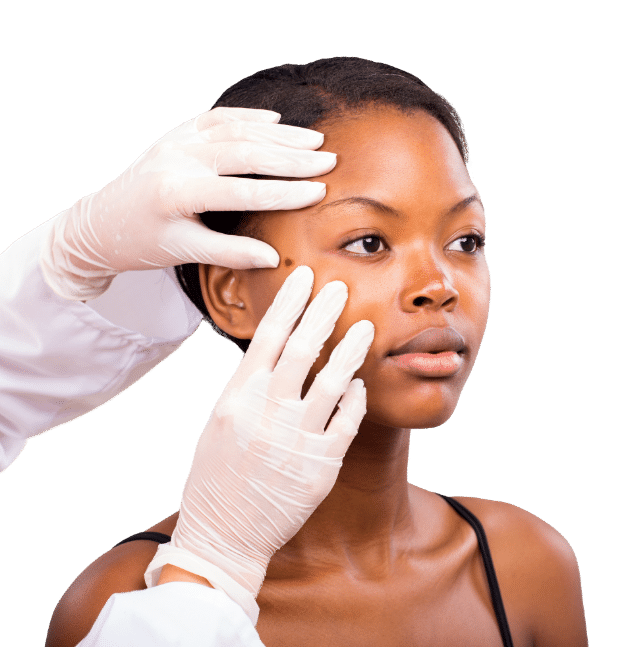Melanoma Education
Skin of Color & Melanoma
Melanoma doesn’t discriminate.
What is skin of color?
According to the Skin of Color Society, “People with skin of color are of diverse racial and ethnic backgrounds, and include African Americans, Asians, Hispanics or Latinos, Native Indians and Pacific Islanders primarily, as well as individuals from these groups who have intermarried.”






In Caucasians, more than 90% of cutaneous (skin) melanomas are thought to be linked to UV exposure.6 This includes UV rays that come from either natural sunlight or from artificial sources like tanning beds or sun lamps.
While UV exposure plays less of a role in the development of melanoma in people of color, other risk factors include:
- Depressed immune system
- Radiation therapy
- Preexisting pigmented lesions
- Albinism
- Burn scars
However, in people of color melanomas that occur on the palms of the hands, soles of the feet, under nails and in mucous sites like the mouth, nasal passages or genitals are more common than cutaneous melanomas.8 These types of melanomas may be classified as acral lentiginous melanomas or mucosal melanomas. Melanoma can also occur in the eye and is known as ocular melanoma.
Facts & Stats for Melanoma in Skin of Color in the U.S.2
Melanoma incidence rates vary by racial group:

African-American
1 PER 100,000

Asian/Pacific Islander
1.6 PER 100,000

Hispanic
4.9 PER 100,000

Alaskan/Native Indian
7 PER 100,000

Non-Hispanic White
37 PER 100,000
What does melanoma look like?
Having your skin checked once each year by a dermatologist, as well as checking your skin at home each month, may help melanoma be caught in its earliest stage. Although melanoma can only be diagnosed with a biopsy, the ABCDE rule can help you and your dermatologist identify a melanoma.
![]() Please hover over the boxes for additional information.
Please hover over the boxes for additional information.


Asymmetrical Shape
Melanomas are often irregular, or not symmetrical, in shape. Benign moles are usually symmetrical.


Border
Typically, non-cancerous moles have smooth, even borders. Melanomas usually have irregular borders that are difficult to define.


Color
The presence of more than one color (blue, black, brown, tan, etc.) or the uneven distribution of color can sometimes be a warning sign of melanoma. Benign moles are usually a single shade of brown or tan.


Diameter
Melanomas are often greater than 6 millimeters in diameter (approximately the size of a pencil eraser).


Evolution
(OR CHANGE)
The evolution of your mole(s) has become the most important factor to consider when it comes to diagnosing a melanoma. Knowing what is normal for YOU could save your life. If a mole has gone through recent changes in color and/or size, bring it to the attention of a dermatologist right away.
How can YOU detect skin cancer early?
The key is early detection, and it starts with YOU. The best way to find skin cancer is to check your own skin. This is crucial because when performed monthly, you can find changes to spots in your skin and get treated appropriately. When detected early, skin cancer can be treated, and often cured. However, in later stages, skin cancer can turn deadly, making treatment difficult.
Here’s what dermatologists recommend for people who have skin of color:
![]()
Skin self-exam: a full body exam of your skin
![]()
Use: a full-length mirror and a partner or a handheld mirror
![]()
Do: monthly
To learn more about how to conduct a self-screen exam, please click below.
Things you can do to protect yourself:
1Stay in the shade whenever possible.
![]()
2Wear sun-protective clothing.
![]()
3Stay away from tanning beds.
![]()
4Wear sunscreen daily.
![]()
- Dermatologists recommend: SPF 30+, broad-spectrum sunscreen, and water resistant.
- Apply sunscreen 15-30 minutes before going outside.
- Reapply every 2 hours and more regularly if you’re sweating or getting wet.
Learn More 
Additional Resources
Citations:
- Merrill SJ, Subramanian M, Godar DE. Worldwide cutaneous malignant melanoma incidences analyzed by sex, age, and skin type over time (1955–2007): Is HPV infection of androgenic hair follicular melanocytes a risk factor for developing melanoma exclusively in people of European-ancestry? Dermato-Endocrinology. 2016;8(1). doi:10.1080/19381980.2016.1215391
- Wu XC, Eide MJ, King J, et al. Racial and ethnic variations in incidence and survival of cutaneous melanoma in the United States, 1999-2006. J Am Acad Dermatol. 2011;65(5 Suppl 1):S26-S37. doi:10.1016/j.jaad.2011.05.034
- Gohara MA. Skin cancer in skins of color. J Drugs Dermatol. 2008;7:441–45
- Pipitone M, Robinson JK, Camara C, Chittineni B, Fisher SG. Skin cancer awareness in suburban employees: A Hispanic perspective. Journal of the American Academy of Dermatology. 2002;47(1):118-123. doi:10.1067/mjd.2002.120450
- Kim M, Boone SL, West DP, Rademaker AW, Liu D, Kundu RV. Perception of skin cancer risk by those with ethnic skin. Archives of Dermatology. 2009;145(2). doi:10.1001/archdermatol.2008.566
- Lucas RM, McMichael AJ, Armstrong BK, Smith WT. Estimating the global disease burden due to ultraviolet radiation exposure. Int J Epidemiol. 2008;37(3):654-667
- Gloster HM, Neal K. Skin cancer in skin of color. J Am Acad Dermatol. 2006;55:741-60
- Acral lentiginous melanoma: Incidence and survival patterns in the United States, 1986-2004. Journal of the American Academy of Dermatology. 2009;60(3). doi:10.1016/j.jaad.2008.11.582
Updated March 2022

